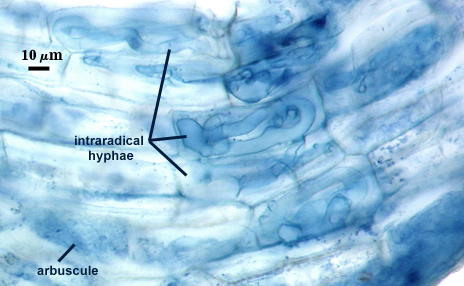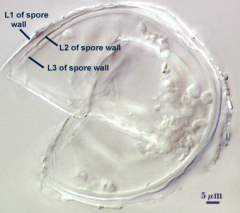Archaeosporaceae - J.B. Morton & Redecker
Molecular Characters
Studies of other molecular characters, such as monoclonal antibody specificities (Wright et al., 1986) and fatty acid profiles (Graham et al., 1995) provided the first evidence that this family, together with species now classified in Ambisporaceae and Paraglomeraceae, were phylogenetically distant from species in Acaulospora and Glomus, but these data did not contain enough phylogenetic information to determine position in a phylogenetic tree. Even morphological characters were atypical for the Acaulospora-like spores (Morton and Benny, 1990). SSU sequences finally provided the character set to position this family as an ancestral clade relative to Acaulosporaceae and Glomeraceae (Redecker et al., 2000; Sawaki et al., 1997). The rDNA gene phylogeny and morphology are congruent in concluding that this family is a separate ancestral lineage from Paraglomeraceae and Ambisporaceae.
Species in the two genera of this family can be distinguished from other glomalean families (including Paraglomeraceae) by the signature nucleotide sequence: TCTCKKYTTCGGYSGAGTCC at position 227 of the SSU gene (Morton and Redecker, 2001). The degeneracy in this sequence reflects variation among species in the group.
Arbuscules
Arbuscules generally stain very faintly (more so than in Acaulosporaceae) in conventional acidic stains. The photo at right has been enhanced digitally to better visualize arbuscule structure. Patchily distributed within roots of corn, red clover and sudangrass (culture hosts used thus far). Narrow trunk hypha (< 4 µm), with fine branching near tips.
Vesicles
Vesicles have not been observed in pot cultures of any isolates of species to date. Loss of these structures by their absence is difficult to prove, but the hypotheses remain that these structures may not have evolved in this group (they are ancestral to other glomalean families) or were lost.

Intraradical Hyphae
Intraradical hyphae tend to stain slightly less faintly than arbuscules and usually are the structures that identify foci of colonization. Spread both intra- and inter-cellularly, the former 3-10 µm wide and often coiled and the latter 2-8 µm wide, with some coiling and irregular branching.
Extraradical Hyphae
Extraradical hyphae generally are thin (2-3 µm wide), but profuse around roots. They often remain attached to roots in entry point regions.
Species Produce Hyaline Asexual Spores
Subcellular structure consists solely of layers of a spore wall of which the outermost layer is continous with the monolayer wall of the neck of the “sporiferous saccule”. Spores do not form thin flexible “germinal walls” common to all species of Acaulosporaceae.
One genus is recognized:
References
- Graham, J.H., N. C. Hodge, and J. B. Morton. 1995. Fatty acid methyl ester profiles for characterization of glomalean fungi and their endomycorrhizae. Applied and Environmental Microbiology 61:58-64.
- Morton, J. B. and G. L. Benny. 1990. Revised classification of arbuscular mycorrhizal fungi (Zygomycetes): A new order, Glomales, two new suborders, Glomineae and Gigasporineae, and two new families, Acaulosporaceae and Gigasporaceae, with an emendation of Glomaceae. Mycotaxon37:471-491.
- Morton, J. B. and D. Redecker. 2001. Two new families of Glomales, Archaeosporaceae and Paraglomaceae, with two new genera Archaeospora and Paraglomus, based on concordant molecular and morphological characters. Mycologia (in press).
- Redecker, D., J. B. Morton, and T. D. Bruns. 2000. Ancestral lineages of arbuscular mycorrhizal fungi (Glomales). Molecular Phylogenetics and Evolution 14:276-284.
- Sawaki, H, K. Sugawara, and M. Saito. 1998. Phylogenetic position of an arbuscular mycorrhizal fungus, Acaulospora gerdemannii, and its synanamorph Glomus leptotichum, based upon 18S rRNA gene sequence. Mycoscience 39:477-480.
- Wright, S. F., J. B. Morton, and J. E. Sworobuk. 1987. Identification of a vesicular-arbuscular mycorrhizal fungus by using monoclonal antibodies in an enzyme-linked immunosorbent assay. Applied and Environmental Microbiology 53:2222-2225.



